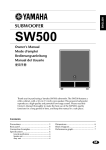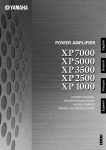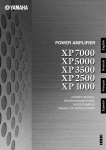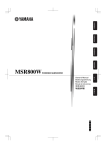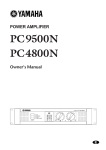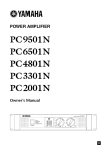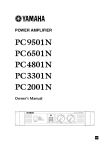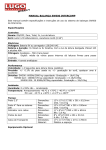Download Yamaha SW500 Owner`s manual
Transcript
ENGLISH SUBWOOFER SW500 Owner’s Manual Mode d’emploi Bedienungsanleitung Manual del Usuario Thank you for purchasing a Yamaha SW500 subwoofer. The SW500 features a reflex cabinet, with a 38 cm (15 inch) cone speaker. This powered subwoofer reproduces a high-quality and powerful low-range sound. Please read this Owner’s Manual thoroughly to make the best use of the SW500’s quality functions for a long period of time, and keep the manual in a safe place. Contents Precautions .............................................. 3 Rear panel ................................................ 4 Connection Examples ............................... 5 Specifications ........................................... 6 Dimensions.............................................. 6 Block Diagram......................................... 7 Performance graph................................... 7 General specifications ..............................................6 Speaker unit ..............................................................6 Amp. unit .................................................................6 M Precautions • Use only the included power cord for this unit. Using other types may be a fire and electrical shock hazard. • Do not allow water to enter this unit or allow the unit to become wet. Fire or electrical shock may result. • Do not place a container with liquid or small metal objects on top of this unit. Liquid or metal objects inside this unit are a fire and electrical shock hazard. • Connect the included power cord only to an AC outlet of the type stated in this Owner’s Manual or as marked on the unit. Failure to do so is a fire and electrical shock hazard. • Do not scratch, bend, twist, pull, or heat the power cord. A damaged power cord is a fire and electrical shock hazard. • Do not place heavy objects, including this unit, on top of the power cord. A damaged power cord is a fire and electrical shock hazard. In particular, be careful not to place heavy objects on a power cord covered by a carpet. • Place the device near a power outlet so you can easily plug it in. • If you notice any abnormality, such as smoke, odor, or noise, or if a foreign object or liquid gets inside the unit, turn it off immediately. Remove the power cord from the AC outlet. Consult your dealer for repair. Using the unit in this condition is a fire and electrical shock hazard. • Should this unit be dropped or the cabinet be damaged, turn the power switch off, remove the power plug from the AC outlet, and contact your dealer. If you continue using the unit without heeding this instruction, fire or electrical shock may result. • If the power cord is damaged (i.e., cut or a bare wire is exposed), ask your dealer for a replacement. Using the unit with a damaged power cord is a fire and electrical shock hazard. • Do not remove the unit’s cover. You could receive an electrical shock. If you think internal inspection, maintenance, or repair is necessary, contact your dealer. • Do not modify the unit. Doing so is a fire and electrical shock hazard. • If lightning begins to occur, turn off the power switch of the unit as soon as possible, and unplug the power cable plug from the electrical outlet. • If there is a possibility of lightning, do not touch the power cable plug if it is still connected. Doing so may be an electrical shock hazard. • Turn off all audio equipment, and speakers when connecting to this unit. Use the correct connecting cables and connect as specified. • Do not subject the speaker to excessive levels, or distorted sounds (indicated by the clip indicator lighting up often) as this leads to overheating and a possible fire hazard. • Always lower the volume control to minimum before turning on the power to this unit. A sudden blast of sound may damage your hearing. • When rack-mounting the unit, allow enough free space around the unit for normal ventilation. This should be: 20 cm at the sides, 25 cm behind, and 30 cm above. For normal ventilation during use, remove the rear of the rack or open a ventilation hole. If the airflow is not adequate, the unit will heat up inside and may cause a fire. • Do not use the handles to suspend the speaker. Otherwise, it may fall, causing injury. • Hold the power cord plug when disconnecting it from an AC outlet. Never pull the cord. A damaged power cord is a potential fire and electrical shock hazard. • This unit is heavy. Use two or more people to carry it. • Do not touch the power plug with wet hands. Doing so is a potential electrical shock hazard. • XLR-type connectors are wired as follows: pin 1: ground, pin 2: hot (+), and pin 3: cold (–). • Using a mobile telephone near this unit may induce noise. If noise occurs, use the telephone away from the unit. • Do not use the speakers at uncomfortably loud level. Otherwise, you may damage your hearing. • Subwoofer SW500 comes with a metal socket for installing the speaker stand. Use a speaker stand pole that is one meter or shorter. Troubleshooting —If the unit shuts down during use— If the CLIP indicator lights up often and you use this unit for a long period of time, the thermostat inside the power transformer will turn the power off. In this case, turn the POWER switch off, wait for a while (about one hour) until the the power transformer cools down, then resume using the unit at a lower input level. Be sure to lower the input level so that the CLIP indicator lights up only momentarily. 3 Rear panel D C SUBWOOFER CONTROL POWER SUBWOOFER MODEL SW500 100 80 0 CUTOFF FREQ. 9 10 LEVEL CLIP 0 E NORM REV PHASE INPUT OUTPUT THRU (+4dB) OU TPUT HIGH PASS 100Hz (+4dB) PARALLEL POWER ON / OFF A A H B B PARALLEL AC IN F A POWER switch This switch turns the power to the SW500 on and off. When this switch is turned on, the green power indicator (9) lights up. B AC IN connector Connect the included power cable here. C CUTOFF FREQ. control This control enables you to adjust the cutoff frequency in the range of 80 through 100 Hz depending on the speakers you are using with the SW500 and your personal preferences. D LEVEL control This control enables you to adjust the sound volume level. The maximum level is at the scale setting of 10, and the minimum level is at the scale setting of 0. If the level is too high, the CLIP indicator (J) lights up red. In this case, lower the level. E PHASE switch This switch enables you to select a phase. You will usually set this switch to ”NORM”. However, the ”REV” setting may improve low-range sounds, depending on the type and location of the entire speaker system. Try both settings and select the one with a better-sounding low-range output. 4 G F INPUT jacks A and B These are XLR-type balanced input jacks. Two different signals can be input at these INPUT jacks and routed to OUTPUT THRU jacks A and B and OUTPUT HIGH PASS A and B jacks respectively. If two signals are input at the same time, they are mixed inside the subwoofer. G OUTPUT THRU jacks A and B These are XLR-type balanced output jacks. Connect these jacks to another subwoofer to route signals input from INPUT jacks A and B to the subwoofer. H OUTPUT HIGH PASS jacks A and B These are XLR-type balanced output jacks. Connect these jacks to the main speakers to cut the range below 100 Hz of signals input from INPUT jacks A and B and route them to the main speakers. I POWER indicator This indicator lights up green when you turn the POWER switch ON. J CLIP indicator This indicator lights up red if the output level is too high. In this case, lower the level using the LEVEL control or lower the input level. Connection Examples ● Using two SW500s Powered speaker L Main speaker L Powered speaker R Main speaker R Amp TEMP PROTECTION A PROTECTION B POWER WATTS/8Ω INPUT 1 0.1 1.0 0.0 5 10 CHANNEL A WATTS/8Ω CLIP/LIMIT 50 100 200 300 INPUT 1 0.1 1.0 0.0 5 10 CLIP/LIMIT 50 100 200 300 18 16 14 20 10 5 2 0 2 4 5 PEAK 30 50 40 +dB 20 10 5 2 0 2 4 5 PEAK +dB CHANNEL B 12 18 25 8 INPUT OUTPUT THRU (+4dB) OU TPUT HIGH PASS 100Hz INPUT OU TPUT HIGH PASS 100Hz OUTPUT THRU (+4dB) (+4dB) INPUT 4 35 2 50 00 0 14 12 10 8 6 4 35 2 50 00 0 OFF OU TPUT HIGH PASS 100Hz OUTPUT THRU (+4dB) (+4dB) 16 25 6 30 30 CHANNEL B POWER AMPLIFIER PROFESSIONAL SERIES 20 10 20 30 50 40 CHANNEL A ON/ INPUT OUTPUT THRU (+4dB) (+4dB) PARALLEL (+4dB) PARALLEL PARALLEL PARALLEL PARALLEL PARALLEL SW500 SW500 L OU TPUT HIGH PASS 100Hz PARALLEL PARALLEL SW500 SW500 R L Mixer R Mixer ● Using a single SW500s Powered speaker L Powered speaker R INPUT OUTPUT THRU (+4dB) OU TPUT HIGH PASS 100Hz (+4dB) PARALLEL PARALLEL SW500 L R Mixer 5 Specifications General specifications Type Bass Reflex powered subwoofer Frequency Range 40–120 Hz (–10 dB) Maximum Output Level 122 dB (1 m on Axis) Dimensiones (W × H × D) 480 × 619 × 590 mm Weight 37 kg Installation pole diameter 35 mm (1.375”) Accessories Power cable 2.5 m (AC inlet type) Controls LEVEL Control CUTOFF FREQ. Control: 80–100 Hz (Variable) PHASE Switch: (REV/NORM) POWER Switch: ON/OFF Connectors INPUT A ,B (XLR-3-31), OUTPUT THRU A, B (XLR-3-32) OUTPUT HIGH PASS A ,B (XLR-3-32) Power Indicator Green LED Clip Indicator Red LED Power Requirement USA and Canada: AC 120 V, 60 Hz Europe: AC 230 V, 50 Hz Others: AC 240 V, 50 Hz Power Consumption 200 W ★ 0 db=0.775 V For European Model Purchaser/User Information specified in EN55103-1 and EN55103-2. Inrush Current: 70 A Conformed Environment: E1, E2, E3 and E4 Speaker unit Speaker Unit 38 cm cone (8Ω) Enclosure Type: Bass Reflex Amp. unit Maximum Output Power 500 W at 100 Hz, THD=1%, RL=8Ω 650 W at 100 Hz, 20 ms nonclip RL=8Ω Input Sensitivity/Impedance +4 dB/30 kΩ (channels A and B) Specifications and appearance are subject to change without notice. 250 Dimensions 590 619 480 Unit: mm 6 Block Diagram 100Hz ch A OUTPUT (HIGH PASS) HPF OUTPUT (THRU) LOW BOOST INPUT (+4dB) LOW CUT LPF LPF PHASE SUM INPUT (+4dB) ch B NORMAL REVERSE OUTPUT (THRU) CUTOFF FREQ (80Hz to 100Hz) 100Hz OUTPUT (HIGH PASS) HPF P.AMP LEVEL BTL SPEAKER Performance graph Standard frequency response +10 Cutoff Frequency 100Hz RESPONSE (dB) 0 90Hz -10 80Hz -20 -30 -40 20 100 1k FREQUENCY (Hz) 7 YAMAHA CORPORATION V792790 R0 1 IP 32 Printed in Taiwan Pro Audio & Digital Musical Instrument Division P.O. Box 3, Hamamatsu, 430-8651, Japan







